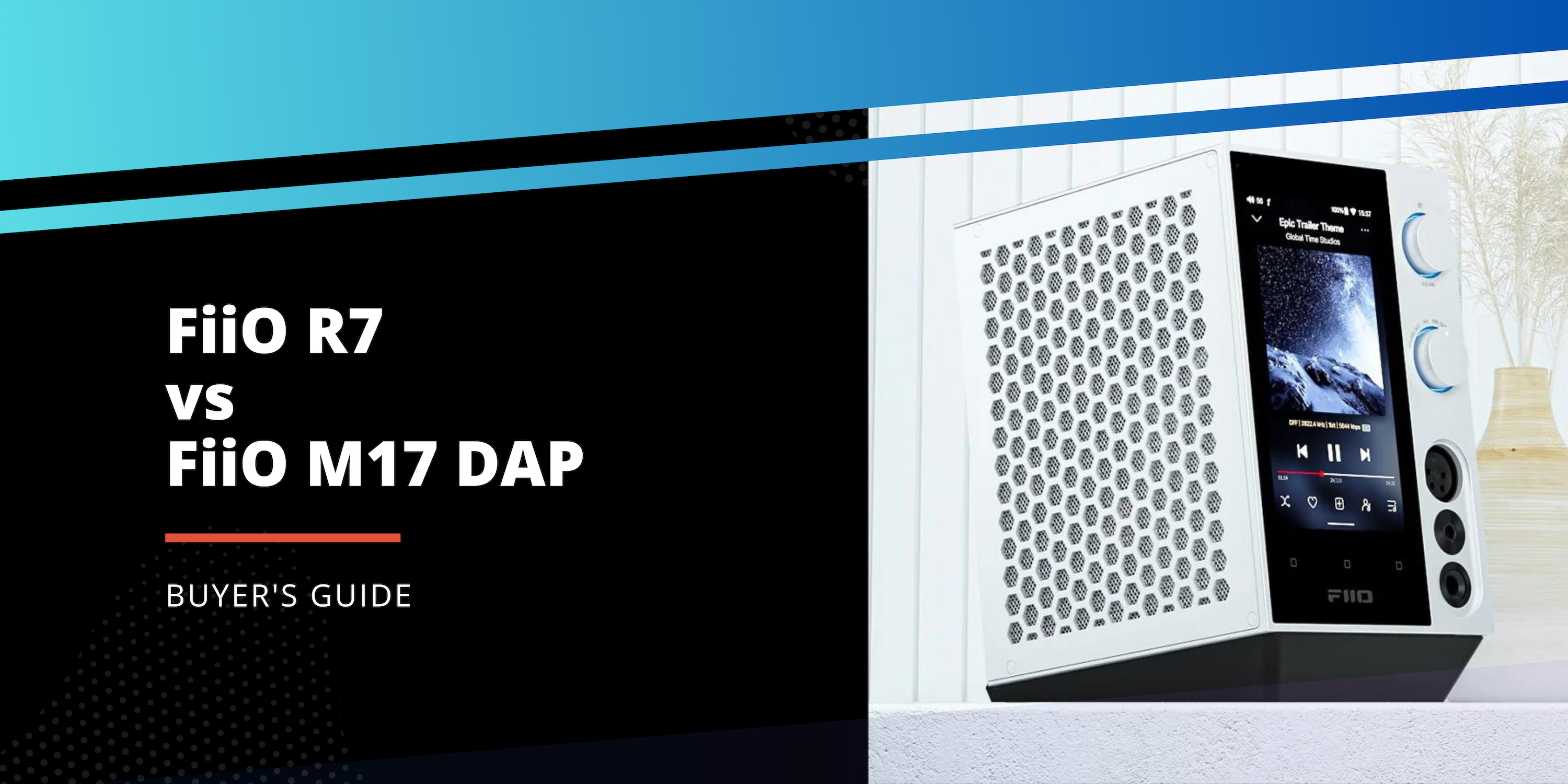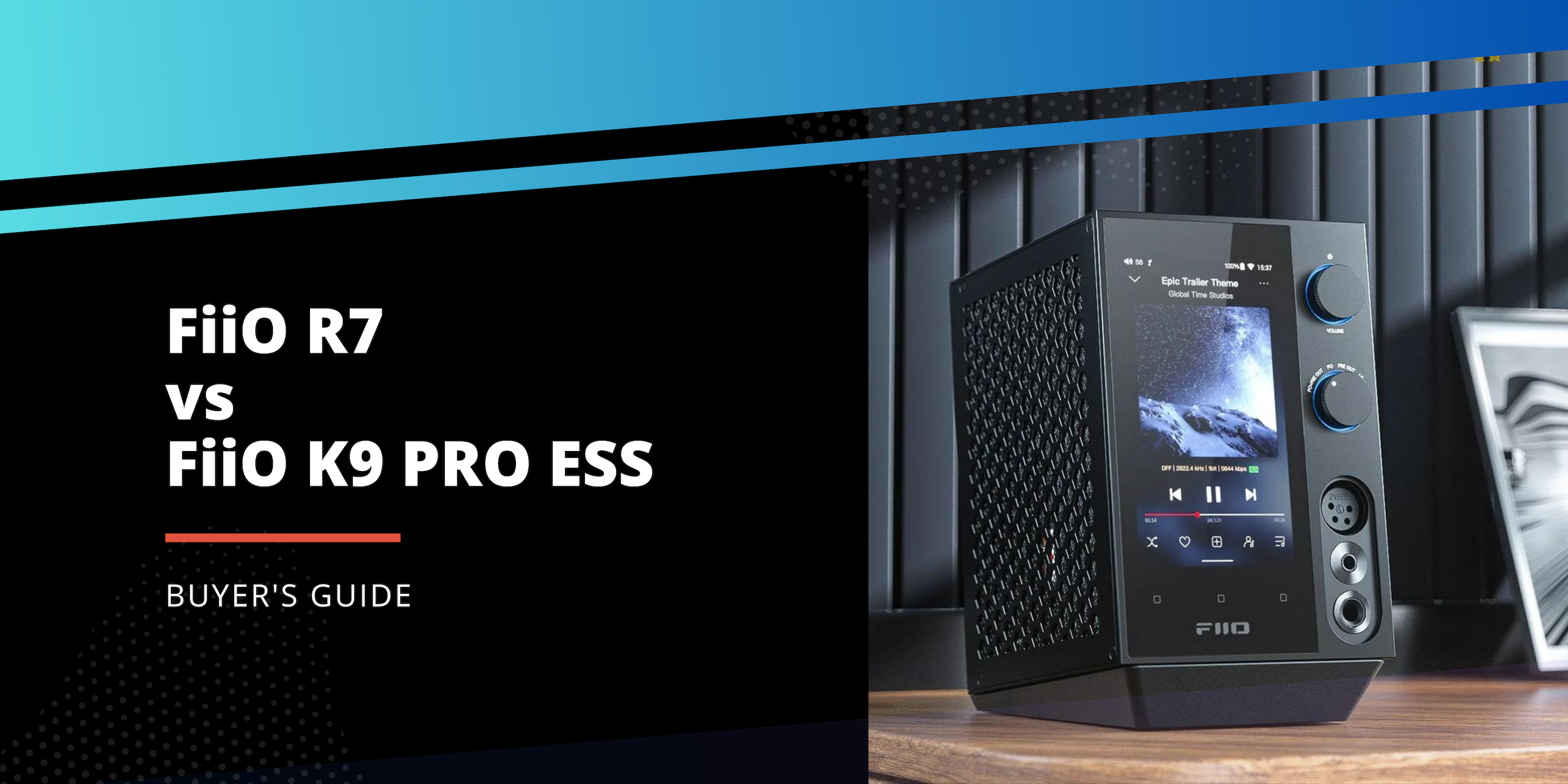
FiiO R7 vs FiiO M17 DAP: HiFi Hub vs Powerful Portable
Introduction
When it comes to high-quality audio devices, the competition is intense, and choosing the right DAC/Amp can make a world of difference to your listening experience. In this comparison, we'll look at two popular models--the FiiO R7 and the FiiO M17--and evaluate them across various product categories, declaring a winner (or a tie) in each.
Digital to Analog Conversion: Winner - FiiO M17
A key difference between the two models lies in their DAC configurations. The R7 employs a dual AK4497EQ DAC setup, while the M17 leverages dual ES9038PRO DAC chips. The ES9038PRO is a more advanced DAC chip offering a higher dynamic range and improved THD+N performance compared to the AK4497EQ, contributing to the M17's slightly superior DAC performance.
Amplification Power: Winner - FiiO M17
The R7 features a single THX AAA 788 amplifier, while the M17 boasts dual THX AAA 788+ amplifiers. The addition of a second amplifier in the M17 delivers more power and improved driving capacity for high impedance headphones, stepping up the audio experience.
Connectivity: Winner - FiiO R7
When it comes to connectivity, the R7 takes the upper hand, offering USB, Coaxial, Optical, IIS LVDS, AES, and Bluetooth 5.0 with LDAC. In comparison, the M17 features USB, Coaxial, Optical, and Bluetooth 5.0 with LDAC. The inclusion of IIS LVDS and AES ports in the R7 provides a wider array of connection options.
Power Output: Winner - FiiO M17
Power output is another category where the M17 shines. It offers up to 1.5W (32 Ohms) in balanced mode, outperforming the R7's balanced output of 1.2W (32 Ohms). This additional power could be critical for users seeking to drive demanding headphones.
Design and Control Interface: It's a Tie
When it comes to design and aesthetics, both the R7 and M17 shine with their high-quality aluminum construction and sleek looks, bringing a sense of modern sophistication to the table. Furthermore, both devices feature a substantial screen for easy navigation—5" on the R7 and an even larger 5.99" display on the M17. Both also share the same user interface, making the operation intuitive and user-friendly. Therefore, in terms of design and control interface, it's a tie between the R7 and M17.
Supported Audio Formats: Tie
Both the R7 and M17 support a wide range of audio formats, including PCM (up to 768kHz), DSD (up to DSD512), and DXD. This means that both devices are equally capable of decoding a variety of high-resolution audio files to deliver the best possible sound quality.
SNR and THD+N: Winner - FiiO M17
While both the R7 and M17 deliver excellent Signal-to-Noise Ratio (SNR) and Total Harmonic Distortion Plus Noise (THD+N) measurements, the M17 edges out the R7 slightly in both categories. This results in a cleaner, clearer, and more detailed sound reproduction from the M17.
Input Impedance and Sensitivity: Tie
Both the R7 and M17 have similar input impedance and sensitivity, making them equally versatile in their compatibility with a range of audio sources and headphones.
Balanced and Unbalanced Outputs: Winner - FiiO M17
While both models offer balanced and unbalanced headphone outputs, the M17 stands out with its XLR balanced preamp outputs, which allows it to integrate seamlessly into a wider range of audio setups, particularly those requiring balanced connections.
Bluetooth Codec Support: Winner - FiiO R7
Although both the R7 and M17 support Bluetooth 5.0 with LDAC, the R7 goes a step further by also supporting aptX, aptX HD, and HWA codecs. This means that the R7 can provide higher quality Bluetooth audio with devices that also support these codecs.
Size and Weight: Winner - FiiO M17
The M17 is more compact compared than the R7; however, it's important to remember that these devices cater to different use cases. The R7, as a desktop DAC/AMP, is designed to be stationary on a desktop. In contrast, the M17 is engineered with portability in mind, allowing users to experience high-quality audio on the go.
Price: Winner - FiiO R7
When it comes to price, the FiiO R7 is the clear winner. At $699.99, it's significantly more affordable than the M17, which comes in at a hefty $1799. While the M17's superior DAC performance, amplification power, and additional features might justify the higher price for some users, those on a tighter budget or who value cost-effectiveness might find the R7 to be a more appealing choice.
Conclusion
After examining these two devices in several categories, it becomes clear that both the FiiO R7 and M17 are excellent choices, each with its own strengths. The M17 takes the lead in areas like DAC performance, amplification power, power output, SNR and THD+N, and balanced outputs. However, the R7 shines in terms of connectivity options, design and control interface, and Bluetooth codec support. Ultimately, the best device for you will depend on your specific audio needs and preferences. Happy listening!


